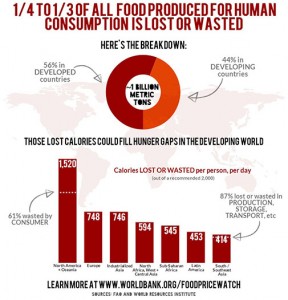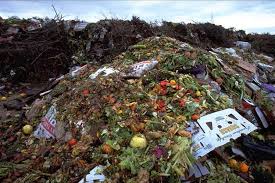The Sad Reality of Wasting Food in a Hungry World
Mar 3rd, 2014 | By admin | Category: Consumption and WasteBy Suzanne York, www.howmany.org
How is this for a factoid about the state of the world today – the world loses or wastes a staggering 25 percent to 33 percent of the food it produces for consumption. This, despite 842 million people going hungry every day.
This is according to according to the latest issue of the World Bank’s quarterly Food Price Watch.
Unsurprisingly there are differences between developed and developing countries; approximately 56% of total food loss and food waste occurs in the developed world; the remaining 44% across developing regions.

Food security is a critical issue, especially in the face of climate change, global land grabs, free trade agreements, genetically-modified foods, conflicts and inequity.
In the United States alone, it is estimated that 40 percent of food goes to waste. A study by the Natural Resources Defense Council found that when the resources to grow that food is considered, it amounts to nearly 25 percent of all freshwater, 4 percent of the oil consumed, and more than $165 billion dollars all dedicated to producing food that never gets eaten.
The United Nations predicts that up to 70 percent more food will be needed to feed a global population of over 9 billion people by 2050.
In other food security news, Lester Brown of the Earth Policy Institute writes that China has become a leading world grain importer, set to buy a staggering 22 million tons in the 2013–14 trade year.
The combination of population growth, rising affluence, and the conversion of one third of the U.S. grain harvest into ethanol to fuel cars is expanding the world demand for grain by a record 43 million tons per year, double the annual growth of a decade ago.
Brown said that “the world is transitioning from an era of abundance to one dominated by scarcity.” But there is much that can be done to ease or even prevent this scenario.
Of course the need to stop wasting food is obvious. The World Bank recommends potential solutions to limit waste, such as changing agricultural production techniques, making large investments in transport and storage infrastructure, and changing consumer and commercial behavior.
Yet there is one other solution that should be a priority, and that is to empower women. This includes investing in sustainable livelihoods and education, ensuring gender equality, recognizing land rights, and respecting reproductive rights. Women are traditional caretakers of their families and their land. In fact, women comprise the largest percentage of agricultural producers in the world.
Ending food waste is something that should easily be done. Empowering women is something that must be done. With the challenges that the world is already facing, and will face, there is no excuse not to do both, and so much more.

